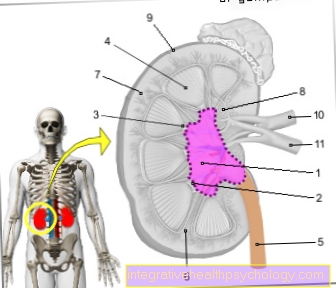Squamous cell carcinoma of the tongue
Definition - What is Squamous Cell Carcinoma of the Tongue?
Squamous cell carcinoma is a malignant tumor or cancer. The description of squamous epithelium refers to the top layer of cells. This generally covers many external and internal surfaces in the body.
Tongue cancer can present itself in different forms. At the beginning of the disease there are usually no or few symptoms. Squamous cell carcinoma often develops on the edge and base of the tongue. It also spreads to the larynx easily.
Also read the article on the topic: Changes in the mucous membrane of the mouth

What are the risk factors?
Risk factors that lead to the development of squamous cell carcinoma include smoking, alcohol, and poor oral hygiene. Chronic mechanical factors, for example a poorly fitting prosthesis, can also be causally involved.
Rather rare risk factors are previous infections with the human papilloma virus HPV or the state after immunosuppression in organ transplant patients. Thermal stimuli, i.e. frequent consumption of very hot drinks or food, are also discussed.
More information about the human papilloma virus: What is HPV?
Diagnosis
An initial indication is obtained from the inspection, i.e. looking at the changed tongue area. The examining doctor then scans the suspicious area. Such tactile findings are suspicious if they are of a hard consistency and cannot be moved. The jaw and neck area should also be scanned from the outside. Hardened lymph nodes can also be found here.
This is followed by a biopsy, i.e. a small tissue sample is taken, which is then examined with a high level of magnification (microscopy). Since cancer cells look completely different to healthy cells under the microscope, this is where the final diagnosis can take place.
It is then important to use an ultrasound head to estimate how far the cancer has grown into the surrounding tissue. A more precise imaging should then be performed. A CT or MRI can be used here. If there is bone pain, especially in the back, PET-CT or bone scintigraphy should be done.
Tumor markers in squamous cell carcinoma of the tongue
In general, tumor markers are not decisive for diagnosis, but rather represent progress parameters after the diagnosis. You are therefore always based on the value measured for the first time. If this increases during control examinations after successful therapy, this is to be understood as an indication of a relapse (recurrence of the cancer).
Tumor markers are measured by taking a blood sample. First the marker “CK-5” (cytokeratin 5) is determined. Since it is also positive for other types of cancer, it must be confirmed with the so-called "P40". If both are positive, one speaks of a high predictive value. Squamous cell carcinoma of the tongue is therefore highly likely. However, it is not enough just to determine the tumor markers for diagnosis.
These symptoms could suggest squamous cell carcinoma of the tongue
The symptoms of squamous cell carcinoma are relatively unspecific, especially at the beginning. It becomes noticeable through a new noticeable mass, the growing into neighboring structures and possibly through tumor necrosis (loss of tissue).
The most common symptoms include:
- local pain
- Foreign body sensation in the mouth
- lumpy language
- bloody saliva
- Bad breath
- Sensory disturbances (sensory disturbances)
- Difficulty swallowing and difficulty speaking and making sounds (this only occurs as soon as the movement of the tongue is disturbed or restricted.)
Read more about the symptoms of tongue cancer at: These are the symptoms that help you recognize cancer of the tongue
Treatment of squamous cell carcinoma of the tongue
The therapy of squamous cell carcinoma of the tongue depends on the stage at which it is discovered at the time of diagnosis and on the consensus of all treating doctors. The specialists involved are (or can be) ENT doctors, oral surgeons, maxillofacial surgeons, plastic surgeons and oncologists.
Treatment for head and neck squamous cell carcinoma is primarily surgical, which means that it is removed by surgery. The resulting pits and gaps can be treated further in complex plastic-surgical operations (for example with covering with your own muscles).
In some cases, chemotherapy or a combination of radiation and chemotherapy (chemoradiotherapy) may also be necessary.
Depending on the infestation, it may also be necessary to remove the lymph nodes in the region concerned. Then an operation takes place on the respective side of the neck from the outside ("neck dissection").
In an incurably advanced stage, palliative treatment is provided. The aim of this is to enable food to be taken for as long as possible and to maintain the quality of life in accordance with the patient's expectations. Surgical measures can also come into play here, which then no longer serve to cure the cancer, but rather allow food to pass through. As with any cancer, supportive measures (support) play an important role here too. Psycho-oncological discussions as well as patient-centered discussions about medical measures at the end of life or in health crises should take place regularly. In particular, due to the prognosis of squamous cell carcinoma of the tongue.
Chemotherapy can cause undesirable side effects. For more information, see: Side effects of chemotherapy
forecast
The prognosis depends on the risk factors and the stage at which the tongue cancer was discovered. In general, tumors on the edge of the tongue have a better prognosis than tumors on the base of the tongue.
For tongue tumors, the prognosis is that 15 to 20 percent of patients are still alive five years after diagnosis (so-called 5-year survival rate).
With tongue edge tumors, 35 to 50 percent of patients are still alive after five years.
Read more about the prognosis of tongue cancer at: What is the life expectancy with tongue cancer?





























